
Ichthyosauria is an order of large extinct marine reptiles sometimes referred to as "ichthyosaurs", although the term is also used for wider clades in which the order resides.

Shonisaurus is a genus of very large ichthyosaurs. At least 37 incomplete fossil specimens of the marine reptile have been found in the Luning Formation of Nevada, USA. This formation dates to the late Carnian age of the late Triassic period, about 237–227 million years ago.
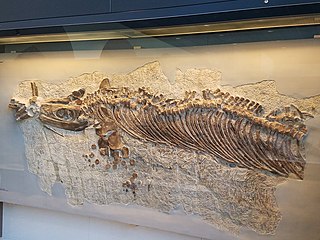
Cymbospondylus is an extinct genus of large ichthyosaurs, of which he is among the oldest representatives, that lived during the Anisian stage of the Middle Triassic in what are now North America and Europe. The first known fossils of this taxon are a set of more or less complete vertebrae which were discovered in the 19th century in various mountain ranges of Nevada, in the United States, before being named and described by Joseph Leidy in 1868. It is in the beginning of the 20th century that more complete fossils were discovered through several expeditions launched by the University of California, and described in more detail by John Campbell Merriam in 1908, thus visualizing the overall anatomy of the animal. While many species have been assigned to the genus, only five are recognized as valid, the others being considered synonymous, doubtful or belonging to other genera. Cymbospondylus was formerly classified as a representative of the Shastasauridae, but more recent studies consider it to be more basal, view as the type genus of the Cymbospondylidae.
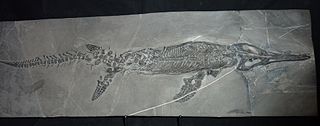
Mixosaurus is an extinct genus of Middle Triassic ichthyosaur. Its fossils have been found near the Italy–Switzerland border and in South China.
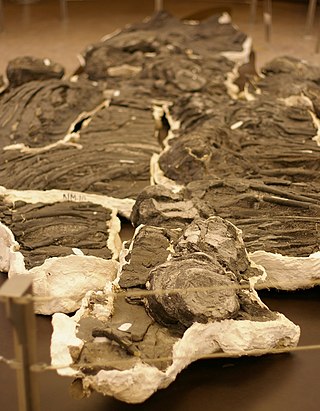
Shastasauridae is an extinct family of Triassic ichthyosaurs that includes the genera Shastasaurus, Shonisaurus and Himalayasaurus. Many other Triassic ichthyosaurs have been assigned to Shastasauridae in the past, but recent phylogenetic analyses suggest that these species form an evolutionary grade of early ichthyosaurs rather than a true clade or evolutionary grouping that can be called Shastasauridae.
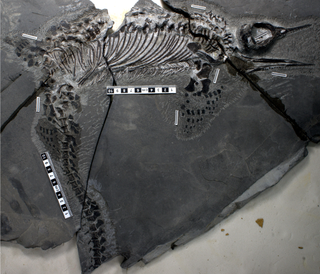
Chaohusaurus is an extinct genus of basal ichthyopterygian, depending on definition possibly ichthyosaur, from the Early Triassic of Chaohu and Yuanan, China.

Shastasaurus is an extinct genus of ichthyosaur from the Late Triassic. Specimens have been found in the United States, Canada, and China.
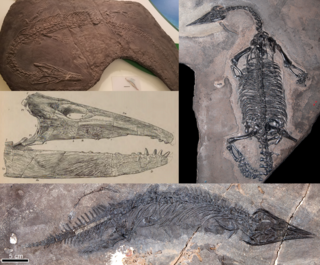
Thalattosauria is an extinct order of prehistoric marine reptiles that lived in the Middle to Late Triassic. Thalattosaurs were diverse in size and shape, and are divided into two superfamilies: Askeptosauroidea and Thalattosauroidea. Askeptosauroids were endemic to the Tethys Ocean, their fossils have been found in Europe and China, and they were likely semiaquatic fish eaters with straight snouts and decent terrestrial abilities. Thalattosauroids were more specialized for aquatic life and most had unusual downturned snouts and crushing dentition. Thalattosauroids lived along the coasts of both Panthalassa and the Tethys Ocean, and were most diverse in China and western North America. The largest species of thalattosaurs grew to over 4 meters (13 feet) in length, including a long, flattened tail utilized in underwater propulsion. Although thalattosaurs bore a superficial resemblance to lizards, their exact relationships are unresolved. They are widely accepted as diapsids, but experts have variously placed them on the reptile family tree among Lepidosauromorpha, Archosauromorpha, ichthyosaurs, and/or other marine reptiles.

Besanosaurus is a genus of Middle Triassic ichthyosaur from Monte San Giorgio of Italy and Switzerland, containing the single species B. leptorhynchus. Besanosaurus was named by Cristiano Dal Sasso and Giovanni Pinna in 1996, based on the nearly complete flattened skeleton BES SC 999, the holotype specimen. This skeleton is preserved across multiple thin rock slabs spanning 3.5 by 4 metres when assembled and took thousands of hours to prepare. Additional specimens from Monte San Giorgio that have previously been considered separate genera, including a partial skull named Mikadocephalus and a well-preserved, largely complete skeleton, have been reinterpreted as additional specimens of Besanosaurus.
Callawayia is an extinct genus of ichthyosaur. It contains the species Callawayia neoscapularis.
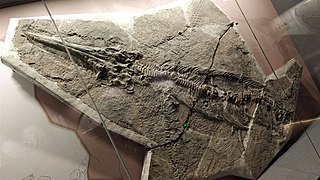
Guizhouichthyosaurus is an extinct genus of ichthyosaur which is known primarily from the Xiaowa Formation of the lower Carnian stage of the Late Triassic in southwest China. The type species of this genus is Guizhouichthyosaurus tangae, of which multiple skeletons are known. It has been reassigned as a species of the genus Shastasaurus in the past, though it has since been considered distinct. The ichthyosaurs Cymbospondylus asiaticus, named in 2002, and Panjiangsaurus epicharis, named in 2003, are junior synonyms of G. tangae. The genus is also known from the Ladinian-aged Middle Triassic Zhuganpo Formation; additionally, the species "Callawayia" wollongangense may belong to Guizhouichthyosaurus.

Qianichthyosaurus is an extinct genus of ichthyosaur from the Ladinian and Carnian stages of the Late Triassic epoch. Its fossils have been found in southeastern China, in Carnian rocks of the Falang Formation near Huangtutang, Guizhou. The type species is Qianichthyosaurus zhoui, named by Chun Li in 1999. A second species, Qianichthyosaurus xingyiensis, was named from older (Ladinian) deposits in the Falang Formation in 2013 by Pengfei Yang and colleagues. Complete Qianichthyosaurus fossils are common in the Xiaowa Formation, with both juveniles and pregnant specimens being known; its larger contemporaries, Guizhouichthyosaurus and Guanlingsaurus, are rarer.
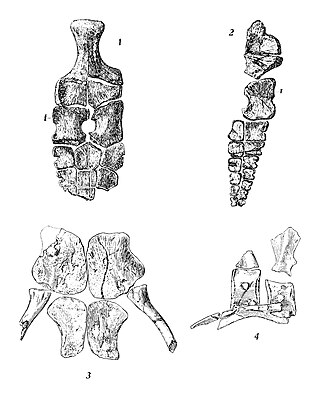
Toretocnemus is an extinct genus of ichthyosaur. Its remains have been found in California, United States, in Triassic layers of the Carnian Hosselkus Limestone.

Anshunsaurus is a genus of thalattosaurs within the family Askeptosauridae. Fossils have been found from Middle Triassic deposits in Guizhou, China. Three species are known: the type species A. huangguoshuensis, the slightly older species A. wushaensis, and the species A. huangnihensis.

Thalattoarchon is a genus of large, Middle Triassic predatory ichthyosaur from North America, containing the single species T. saurophagis. The taxon was described in 2013 from a single specimen discovered in the Favret Formation in Nevada. The generic name, meaning "ruler of the seas", refers to its status as an apex predator, while the specific epithet, meaning "lizard eater", alludes to its carnivorous diet. The classification of this genus within the ichthyosaurs is much debated, being either classified within the clade Merriamosauria or in the more basal family Cymbospondylidae.
Xinminosaurus is an extinct genus of cymbospondylid ichthyosaur known from the Middle Triassic of Guizhou Province, China.

Cartorhynchus is an extinct genus of early ichthyosauriform marine reptile that lived during the Early Triassic epoch, about 248 million years ago. The genus contains a single species, Cartorhynchus lenticarpus, named in 2014 by Ryosuke Motani and colleagues from a single nearly-complete skeleton found near Chaohu, Anhui Province, China. Along with its close relative Sclerocormus, Cartorhynchus was part of a diversification of marine reptiles that occurred suddenly during the Spathian substage, soon after the devastating Permian-Triassic extinction event, but they were subsequently driven to extinction by volcanism and sea level changes by the Middle Triassic.

This timeline of ichthyosaur research is a chronological listing of events in the history of paleontology focused on the ichthyosauromorphs, a group of secondarily aquatic marine reptiles whose later members superficially resembled dolphins, sharks, or swordfish. Scientists have documented ichthyosaur fossils at least as far back as the late 17th century. At that time, a scholar named Edward Lhuyd published a book on British fossils that misattributed some ichthyosaur vertebrae to actual fishes; their true nature was not recognized until the 19th century. In 1811, a boy named Joseph Anning discovered the first ichthyosaur fossils that would come to be scientifically recognized as such. His sister Mary would later find the rest of its skeleton and would go on to become a respected fossil collector and paleontologist in her own right.



























